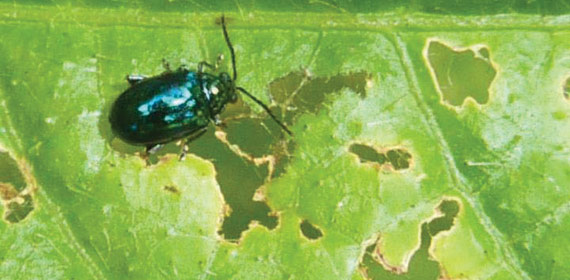The most worrisome flea beetle, from an economic point of view, but also for gardeners close to farms, is the one that attacks canola crops and cruciferous (brassica) vegetables. On certain calm, hot summer days, your garden may be invaded by a swarm of these bugs flying in from nearby canola fields. The bad news: they can do a lot of damage in a short period. The good news: they don’t often stay too long. Unfortunately, they also spread bacterial and viral diseases.
Flea beetle damage, in its early stages, looks like flecks of white or gray pepper on the leaves of plants. Later, these “flecks” become shot holes that make it look as though someone hit the plant with a fine shot gun. Heavily damaged leaves may become lacy.
Flea beetles are so named because they hop like fleas. The beetles have strong hind legs that help them spring up when disturbed.
Many types of flea beetles
There are many types of flea beetles preying on specific plants but you can have several types preying on one plant. They are all small, 1/16 to 1/8th of an inch, and have those tell-tale strong hind legs, but colour of their coats can vary. The base hue is shining black, sometimes with an iridescence of green or purple, but some might be black with two shiny, wavy yellow stripes, or they might have many yellow stripes. There is one, the eight-spotted flea beetle, which has a red head and eight large white spots on a black field on its back.
Flea beetles enjoy warm, dry sunny days when they actively feed and the can even fly if it’s over 14 C. They don’t like rain and will hide on the underside of leaves.
Many flea beetles love cruciferous plants, including cabbages, mustards and the prairie-ubiquitous canola. On certain warm, dry July days they will swarm into cities, blanketing and destroying urban gardens. One group favours solanaceous plants which include tomatoes, potatoes, and pepper. Still another group enjoy squash, beans, corn, sunflowers and lettuce.
Flea beetles overwinter as adults in shrubby places, emerging to lay eggs in the soil at the base of plants when the temperatures exceed 10 to 14 C. At cooler temperatures, they will hop from plant to plant. As the weather warms they will take to the air. The adults lay their eggs in the soil near vulnerable seedlings so using diatomaceous earth when planting may help deter infestations. Plants are most vulnerable at the cotyledon stage as the pale, cream-coloured larvae (1/8th to 1/3rd inch long) are voracious feeders on tender stems and leaves.
To protect from flea beetles
To protect your emerging plants, sprinkle the soil around them with diatomaceous earth or use floating row to keep the beetles out. There are also beneficial nematodes, predatory braconid wasps and tachinid flies that will come to your defence. Kaolin clays can be sprayed on older crops.
Planting a trap crop of mustard or radish will lure the adults to their favoured food, assuming that is the variety of flea beetle you are trying to avoid. Interplant the veggie crop with thyme, catnip or mint to confuse them with the strong, masking scent of these plants. Dust tomatoes, potatoes and peppers with talcum powder to repel the beetles. Spray a concoction of two parts rubbing alcohol, five parts water and one tablespoon of liquid soap spray on foliage.
Just as with everything else, some flea beetles are considered to be helpful in that they will attack noxious weeds such as leafy spurge. Aphthona nigriscutis has been used as a biological control of this imported weed, Euphorbia esula, which produces latex is harmful to cattle.
Dorothy Dobbie is the owner of Pegasus Publications and Manitoba Gardener. Listen to her weekly radio show on CJNU 93.7 Sunday mornings at 8:00.



